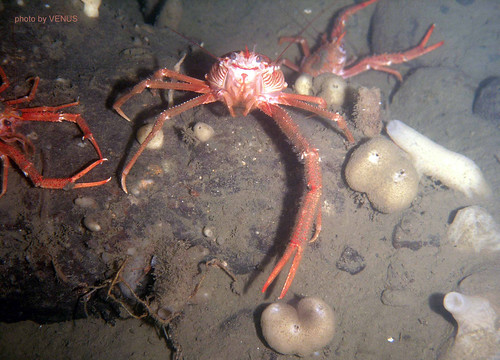Say Cheese!
VENUS Image of a squat lobster at a depth of 90 meters using the instrument's digital camera.
The Victoria Experimental Network Under the Sea (VENUS) facility, led by the University of Victoria, Canada, recently opened a data portal that provides access to scientists and the general public to an online warehouse of images, sounds and live data from the ocean floor.
The $10.3 million VENUS facility offers the world's first interactive, real time portal to the ocean. The underwater network of fiber optic cables and instruments, connected to the Internet, provides a portal to the ocean whenever we wish, and allows scientists to operate their instruments and download data online, day or night, in real time.
The 3 kilometer network of fiber optic cables and instruments that comprises the first leg of VENUS was installed in Saanich Inlet in February. Information has been streaming in since then. A second, 40 kilometer leg will be installed in the Strait of Georgia near Vancouver later in 2006.
At the heart of VENUS is a centralized data management and archive system that offers unrestricted access to long-term ocean observations.
"It is a very advanced software 'structure' that was developed at the University of Victoria and sets new standards in data capture, access and delivery," says Verena Tunnicliffe, VENUS project director and marine biologist.
The four key features of the data management and archive system are: data acquisition and storage; easy user access to data; observatory monitoring; and the control of instruments by VENUS scientists.
"This is a remarkable resource and represents a year of hard work by a 13-member team," says Tunnicliffe.
VENUS instruments collect several gigabytes of information every 24 hours. Already, after four-and-a-half months of operation, VENUS has archived more than 35 million measurements and dozens of gigabytes of acoustic and visual data. That information, and new real time data, is now available to the world.
The data management system is constantly evolving. In the near future, "software agents" will work on behalf of VENUS scientists, monitoring incoming data and alerting them by e-mail or cell phone if an unusual event or trend occurs that warrants immediate attention.
Over its proposed 20 year lifespan, VENUS will support studies on a variety of topics such as long-term ocean change; tides, currents and mixing; fish and marine mammal movements; seafloor community ecology; underwater noise pollution; sediment and slope dynamics; and plankton behavior.
VENUS is funded by the Canada Foundation for Innovation, the British Columbia Knowledge Development Fund, and other contributions from federal agencies, industry and sponsors. Its data management and storage system is shared with the larger NEPTUNE Canada seafloor observatory project, also led by the University of Victoria.
.

